The Children's Floor - Grand Duchesses's Classroom
Preparing Young Princesses for the Future
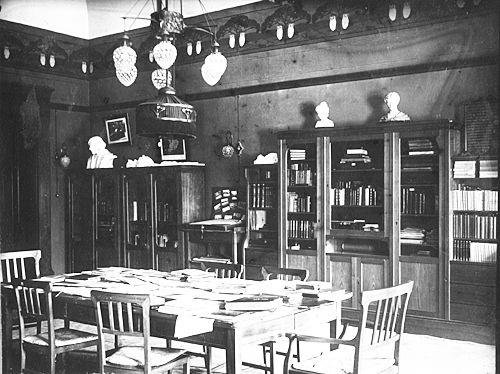
The classroom of the Grand Duchesses was decoratecd with an olive-colored wallpaper and a stencilled frieze of pine cones and owls. On the floor was a sewn carpet in dark navy blue carpet. The room had a large table surrounded by chairs with footstools. Fabric depicting stylized tulips covered the chairs and was used for curtains. In the corner stood a big green-tiled Russian stove.
Large bookcases were filled with standard text books on serious subjects such as geology, history and mathematics. For scientific study a skull stood on top one of the big glass-doored bookcases that lined the room. From the center of the ceiling hung a large chandelier with hanging red and white-nubbed glass tear-drop shades. In the middle of the fixture hung an adjustable cloth-shaded light, which illuminated the work table. There were two classrooms for the Grand Duchesses in the palace. The second was over Nicholas's Reception Room and was used for music and dance instruction.
Perre Gilliard describes his first days as a tutor to the Grand Duchesses at the Lower Palace at Alexandria/Peterhof:
"On the day appointed for my first lesson a royal carriage came to take me to Alexandria Cottage, where the Tsar and his family were residing. Yet in spite of the liveried coachman, the Imperial arms on the panels, and the orders with regard to my arrival which had no doubt been given, I learned to my cost that it was no easy task to enter the residence of Their Majesties. I was stopped at the park gates, and there were several minutes of discussion before I was allowed to go in. On turning a comer I soon observed two small brick buildings connected by a covered bridge. If the carriage had not stopped I should not have known I had arrived at my destination.Bob AtchisonI was taken up to a small room, soberly furnished in the English style, on the second storey. The door opened and the Tsarina came in, holding her daughters Olga and Tatiana by the hand. After a few pleasant remarks she sat down at the table and invited me to take a place opposite her. The children sat at each end.
The Tsarina was still a beautiful woman at that time. She was tall and slender and carried herself superbly. But all this ceased to count the moment one looked into her eyes - those speaking, grey-blue eyes which mirrored the emotions of a sensitive soul.
Olga, the eldest of the Grand-Duchesses, was a girl of ten, very fair, and with sparkling, mischievous eyes and a slightly retroussŽ nose. She examined me with a look which seemed from the first moment to be searching for the weak point in my armor, but there was something so pure and frank about the child that one liked her straight off.
The second girl, Tatiana, was eight and a half. She had auburn hair and was prettier than her sister, but gave one the impression of being less transparent, frank, and spontaneous.
The lesson began. I was amazed, even embarrassed, by the very simplicity of a scene I had anticipated would be quite different. The Tsarina followed everything I said very closely. I distinctly felt that I was not so much giving a lesson as undergoing an examination. The contrast between anticipation and reality quite disconcerted me. To crown my discomfort, I had had an idea that my pupils were much more advanced than they actually were. I had selected certain exercises, but they proved far too difficult. The lesson I had prepared was useless, and I had to improvise and resort to expedients. At length, to my great relief, the clock struck the hour and put an end to my ordeal.
In the weeks following the Tsarina was always present at the children's lessons, in which she took visible interest. Quite frequently, when her daughters had left us, she would discuss with me the best means and methods of teaching modern languages, and I was always struck by the shrewd good sense of her views.
Of those early days I have preserved the memory of a lesson I gave a day or two previous to the issue of the Manifesto of October, 1905, which summoned the Duma. The Tsarina was sitting in a low chair near the window. She struck me instantly as absent-minded and preoccupied. In spite of all she could do, her face betrayed her inward agitation. She made obvious efforts to concentrate her thoughts upon us, but soon relapsed into a melancholy reverie in which she was utterly lost. Her work slipped from her fingers to her lap. She had clasped her hands, and her gaze, following her thoughts, seemed lost and indifferent to the things about her.
I had made a practice, when the lesson was over, of shutting my book and waiting until the Tsarina rose as a signal for me to retire. This time, notwithstanding the silence which followed the end of the lesson, she was so lost in thought that she did not move. The minutes passed and the children fidgeted. I opened my book again and went on reading. Not for a quarter of an hour, when one of the Grand-Duchesses went up to her mother, did she realise the time.
After a few months the Tsarina appointed one of her ladies-in-waiting, Princess Obolensky, to take her place during my lessons. She thus marked the end of the kind of trial to which I had been subjected. I must admit the change was a relief. I was far more at my ease in Princess Obolensky's presence, and besides, she gave me devoted help. Yet of those first months I have preserved a vivid recollection of the great interest which the Tsarina, a mother with a high sense of duty, took in the education and training of her children. Instead of the cold and haughty Empress of which I had heard so much, I had been amazed to find myself in the presence of a woman wholly devoted to her maternal obligations.
It was then, too, that I learned to realise by certain signs that the reserve which so many people had taken as an affront and had made her so many enemies was rather the effect of a natural timidity, as it were - a mask covering her sensitiveness.
I will give one detail which illustrates the Tsarina's anxious interest in the upbringing of her children and the importance she attached to their showing respect for their teachers by observing that sense of decorum which is the first element of politeness. While she was present at my lessons, when I entered the room I always found the books and notebooks piled neatly in my pupils' places at the table, and I was never kept waiting a moment. It was the same afterwards. In due course my first pupils, Olga and Tatiana, were joined by Marie, in 1907, and Anastasia, in 1909, as soon as these two younger daughters had reached their ninth year.

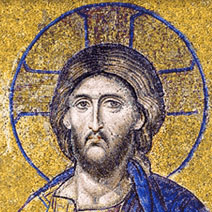



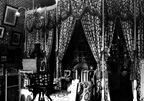 Imperial Bedroom
Imperial Bedroom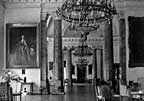 Portrait Hall
Portrait Hall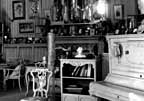 Mauve Room
Mauve Room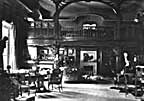 Maple Room
Maple Room Aleksey's Bedroom
Aleksey's Bedroom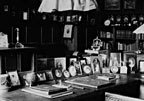 Nicholas's Study
Nicholas's Study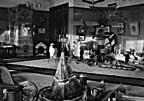 Aleksey's Playroom
Aleksey's Playroom Formal Reception
Formal Reception Balcony View
Balcony View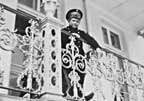 Aleksey- Balcony
Aleksey- Balcony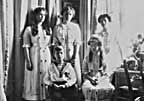 Children-Mauve
Children-Mauve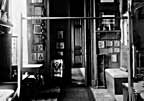 Nicholas's Bathroom
Nicholas's Bathroom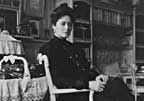 Alexandra- Mauve
Alexandra- Mauve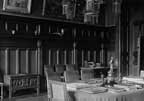 Nicholas's Reception
Nicholas's Reception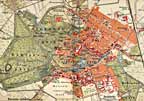 Tsarskoe Selo Map
Tsarskoe Selo Map